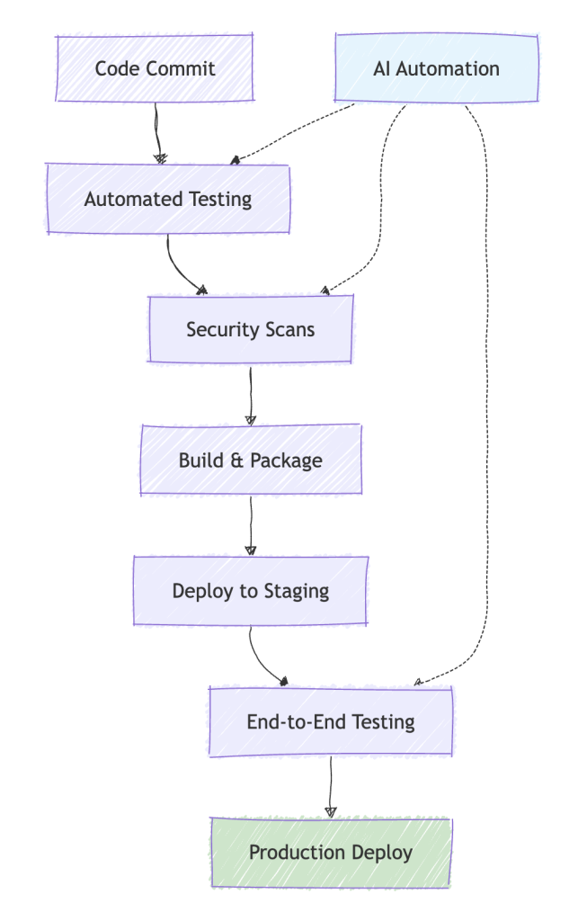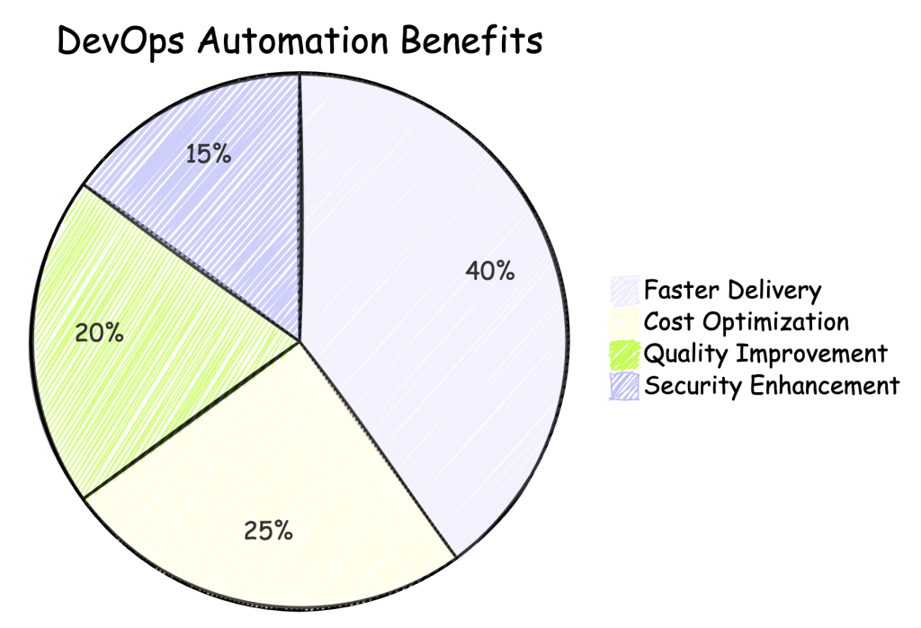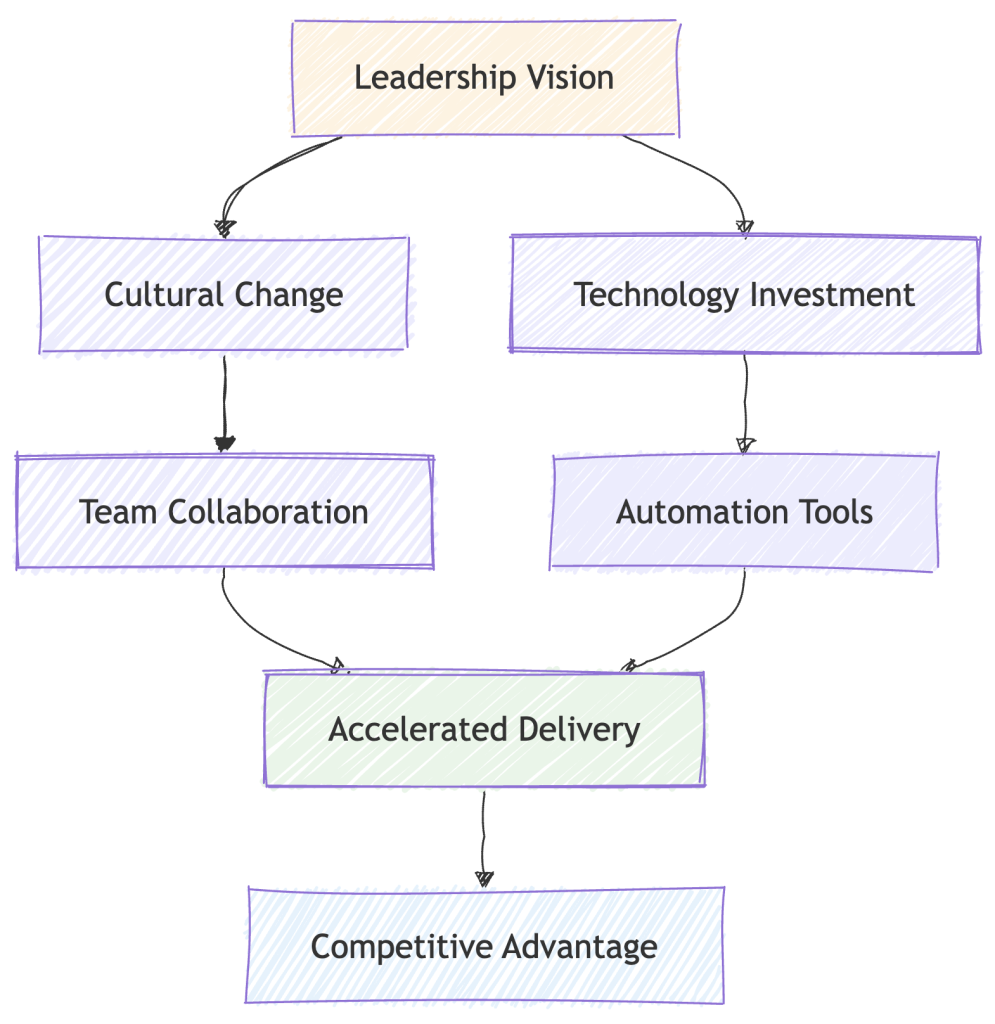How DevOps Automation Accelerates Software Delivery: A Leadership Perspective
Recently we realized something. Some companies just move differently, when they figure out this whole DevOps automation thing before everyone else did. As, one of our clients just pushed their fourth feature update this week. Fourth! And we’re thinking… their main competitor is still stuck planning some big quarterly release that probably won’t happen on time anyway.
The research backs this up too. The DevOps market size will surpass $25.5 billion by 2028, which tells you everything about where smart money is going. 83% of developers adopt DevOps in one form or another. That’s not a trend anymore, that’s just how business gets done now.
Most Dev Teams Are Moving Like They’re Stuck in Mud
You know that feeling when you’re behind someone driving 30 km/h in the fast lane? That’s what traditional software development feels like now.
Your developers finish something cool. Then… crickets. QA needs forever to get environments working. Ops wants meetings about meetings before they’ll even think about deployment.
What is DevOps? Honestly??? The Long-Term Solution. What happens when you actually tear down those stupid walls between teams? Suddenly, people start caring about the whole process, not just their tiny piece of it.
We’ve helped companies go from taking months to deploy simple changes to doing it in a few hours. Implementing DevOps helps companies produce higher-quality deliverables while reducing time-to-market.

Traditional Method to DevOps Automation
DevOps Automation Isn’t What You Think It Is:
Everyone hears “automation” and freaks out about robots stealing jobs or whatever. – Totally Wrong movie entirely.
Think of DevOps automation more like… having that one coworker who actually remembers everything, never calls in sick, and doesn’t make dumb mistakes when they’re tired. Except this coworker works 24/7 and never gets grumpy.
The numbers tell the story. DevOps automation tools market size grew from $9.74 billion in 2023 to $12.11 billion in 2024 – a 24.4% growth rate. That’s companies scrambling to catch up.
Recently our DevOps pipelines caught a bug last week that would’ve definitely slipped past human review. Not because humans suck at their jobs – just because computers are weirdly good at spotting certain patterns we miss.
And this AI automation stuff? Getting crazy good. These systems learn how your team works and start catching problems before they become… well, problems. The automation in DevOps isn’t replacing human judgment – it’s amplifying it.

CICD – Continuous Integration & Continuous Delivery/Deployment
CI/CD Actually Changes Lives (Sounds Dramatic But True)
Recall those horrifying, scary deployment weekends? Pizza boxes everywhere, everyone stressed, praying nothing breaks at 2 AM? CI/CD kills all that.
Now our clients deploy whenever they want. Tuesday afternoon? Sure. Thursday morning before coffee? Why not.
End-to-end testing that finishes in fifteen minutes keeps people engaged. Deployment performance is actually worse when using multiple CI/CD tools of the same form – more tools don’t always mean better results. Believe us, we have seen that.
Security Teams Finally Getting It too (Took Long Enough)
The security conversations we’ve sat through…
“We absolutely cannot automate security!” they’d insist. “What if something sneaks through?”
Plot twist – automated DevSecOps catches way more stuff than manual reviews ever did. Plus it catches problems immediately instead of three weeks later when fixing them costs a fortune.
In one of our implementations, automated scans now flag potential issues within minutes of code getting committed, issues created & assigned to the developer who wrote it, team fixes stuff while developers still remember what they were thinking.

DevOps Automation Benefits
Cloud Services Saved Everyone’s Sanity
DevOps services just make sense. Enterprise-level stuff without the enterprise-level headaches.
Some companies we work with use DevOps consulting services to get started faster. Smart move if your team’s already drowning. DevOps consulting helps navigate the people side of things, which honestly is way harder than the technical stuff.
Cost optimization always shocks people. One client’s infrastructure bill dropped 38% after automation started managing their resource scaling. GenAI services analyze usage patterns and suggest improvements that humans just don’t think of.
Leadership Stuff They Don’t Teach You
DevOps automation isn’t really about technology. It’s about convincing people to work differently.
Your biggest challenge won’t be picking tools or configuring automation in DevOps workflows. It’ll be explaining to your accounting manager why deploying more often is actually safer. It’ll be helping your ops team understand that automation makes their work more interesting, not obsolete.
I’ve learned to make a big deal about small wins. First automated deployment? Team celebration. Cut deployment time by half? Company announcement. Seems silly but it works.
The culture change is everything. Tools will be just mere tools unless their real potential is used & to adopt DevOps practices, leadership has to actively encourage adoption instead of just hoping it happens naturally. That is what we are currently doing with AI & Gen AI.

Leadership, Cultural Change to Competitive Advantage
What Success Feels Like
You know it’s working when devs stop complaining about deployments & the whole team starts suggesting automation ideas instead of fighting them.
Yes, we track deployment frequency and recovery times and all that. But the real proof? Customers notice. Bugs get fixed faster. New features show up quicker. People are happier.
One client deploys to production six times a day now. Their system reliability actually improved because smaller changes are easier to troubleshoot when something does go wrong.
The measurement piece is crucial, though. You need to track lead time for changes, deployment frequency, mean time to recovery, and change failure rate. These four metrics tell you more about your delivery capability than any other indicators.
What’s Coming Next (It’s Moving Fast)
The pace of change in automation in DevOps is honestly a bit much sometimes. Serverless everything, edge computing, AI that practically codes itself…
My advice? Build flexible foundations now. Specific tools will keep changing but the core principles – automated, reliable, fast delivery – those stick around.
Bottom Line Time
DevOps automation works. I’ve watched it transform companies from bureaucratic slowpokes into market leaders. But you need commitment from leadership.
Keep doing things the old way and hope competitors don’t figure this out. Or start building a competitive advantage today. I would bet on the latter.
The research couldn’t be clearer – the DevOps market size will surpass $25.5 billion by 2028. Companies are voting with their wallets, and they’re choosing speed over the status quo.
In my experience – been at this for a while now – companies that master accelerated software delivery don’t just react to market changes. They cause them.
Pretty simple choice when you think about it. Speed wins. DevOps automation gets you that speed. Everything else is just implementation details.



